Disability statistics - financial situation
Data extracted in: October 2023.
Planned article update: December 2024
Highlights
In 2022, 40.5 % of people in the EU with a disability could not afford a one-week annual holiday.
In 2022, 11.7 % of people in the EU with a disability could not afford to eat meat, fish or a vegetarian equivalent at least every other day.
In 2022, 38.9 % of people in the EU with a disability could not meet unexpected financial expenses.
Share of people aged 16 years or over living in households that reported having difficulties in making ends meet, by level of disability (activity limitation), 2022
This article is part of a set of articles on disability and presents various aspects of the financial situation of people with a disability (activity limitation). The findings presented in this article are based on the European Union's (EU) statistics on income and living conditions (EU-SILC). These are based on respondents' assessments of their disability / activity limitation as well as their household's financial situation. The data presented in this article generally cover persons aged 16 years and over. One analysis focuses specifically on persons aged 65 years and over.
In EU-SILC, disability is approximated according to the concept of global activity limitation, which is defined as a 'limitation in activities people usually do because of health problems for at least the past six months'. This is considered to be an adequate proxy for disability, both by the scientific community and organisations representing people with disabilities. This definition is in also in line with the concept of disability as set out in the European disability strategy 2010–2020 and its successor, the Strategy for the rights of persons with disabilities 2021–2030.
The financial situation of households has become a key area of concern during the cost-of-living crisis. A growing share of the EU population, particularly those in vulnerable situations, face difficulties in paying their energy bills and affording sufficient food. The links between poverty and ill-health suggest that the cost-of-living crisis may worsen health inequalities across the EU.
Full article
Struggling to make ends meet
People with a disability are more likely to struggle to make ends meet
Financial difficulties: households are asked, for example, whether they struggle to make ends meet, whether they can afford to go away for a one-week holiday once a year, or whether they can afford to eat meat or fish (or a vegetarian equivalent) regularly.
In 2022, 26.0 % of people aged 16 years and over with a disability (having some or severe activity limitations) in the EU lived in households that reported having difficulties in making ends meet; in other words, their financial resources did not cover their usual necessary expenses. For comparison, the share was 16.7 % among the population without a disability (no activity limitations) – see Figure 1.
In all EU Member States, people with a disability were more likely to have difficulties in making ends meet in 2022 than people without a disability. The proportion of people with a disability living in a household that reported suffering such financial difficulties was
- above 50.0 % in Greece (76.7 %), and Bulgaria (55.7 %),
- less than one sixth in Czechia (16.6 %), Denmark (15.8 %), Sweden (13.9 %), Germany (13.2 %; low reliability), the Netherlands (12.1 %), Finland (11.5 %) and Luxembourg (8.0 %).
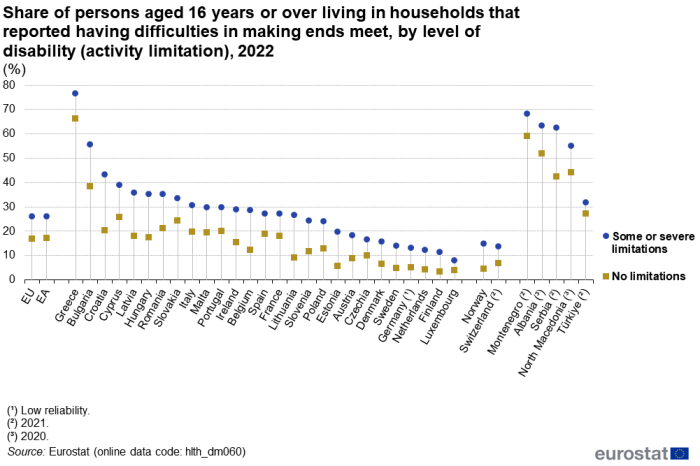
(%)
Source: Eurostat (hlth_dm060)
One-week annual holiday
40.5 % of people with a disability could not afford a one-week annual holiday
One of the consequences of difficult financial circumstances is being unable to go on holiday measured as being unable to afford a one-week holiday once a year – see Figure 2. In the EU in 2022, people aged 16 years and over with a disability were more likely to find themselves in this position (40.5 %) compared with people (of the same age) not having a disability (24.9 %).
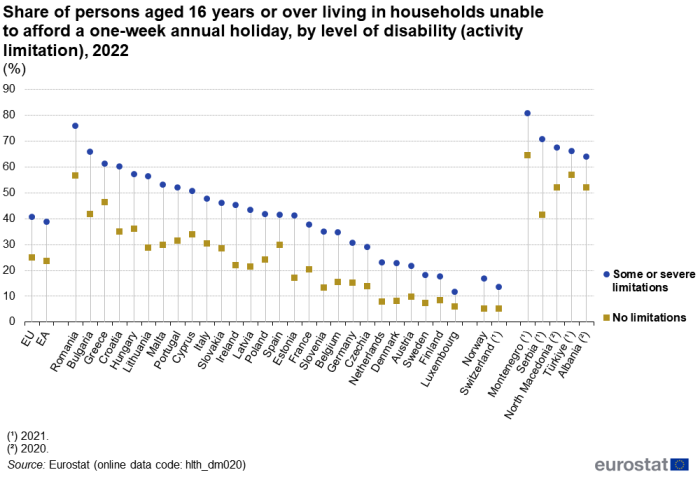
(%)
Source: Eurostat (hlth_dm020)
In all EU Member States, the share of people living in households unable to afford a one-week annual holiday was higher among those with a disability than those without a disability. In 2022, the proportion of people with a disability who lived in a household unable to afford a one-week annual holiday was notably higher in eastern EU Member States and Greece: 75.8 % in Romania, 65.9 % in Bulgaria, 61.1 % in Greece and 60.0 % in Croatia. The lowest values were observed in Finland (17.6 %) and Luxembourg (11.6 %).
Meat, fish or a vegetarian equivalent at least every other day
11.7 % of people with a disability were unable to afford to eat meat, fish or a vegetarian equivalent at least every other day
The financial difficulties faced by people with a disability in the EU can also be seen by the fact that, in 2022, 11.7 % lived in households that were unable to afford to eat meat, fish or a vegetarian equivalent at least every other day. The proportion of the population without a disability in a similar situation was notably lower, at 6.5 %.
In all EU Member States, people with a disability were more likely than people without a disability to live in a household that was unable to afford to eat meat, fish or a vegetarian equivalent at least every other day. In 2022, the percentage of people with a disability living in a household unable to afford to eat meat, fish or a vegetarian equivalent at least every other day varied greatly between EU Member States, ranging from 3.0 % in Cyprus and 3.1 % in Luxembourg to upwards of 20.0 % in Slovakia, Hungary, Romania and Bulgaria (where the highest share was recorded, at 32.6 %).
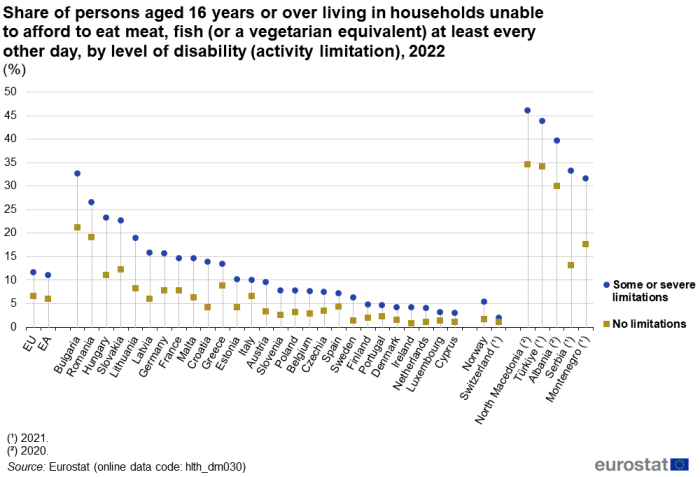
(%)
Source: Eurostat (hlth_dm030)
Unexpected financial expenses
38.9 % of people with a disability would be unable to meet unexpected financial expenses
In 2022, 38.9 % of people with a disability in the EU lived in households which would be unable to meet unexpected financial expenses, compared with 27.4 % among people without a disability.
Being unable to meet unexpected financial expenses means that a household would be unable to cover an unexpected essential expense from its own resources, that is, without asking for help: for example, borrowing money from friends or family, going overdrawn on a bank account, or worsening its situation with regard to potential debts. Examples of essential expenses are having surgery, paying for a funeral, having major repairs carried out in the house or replacing durable goods (such as a washing machine or a car).
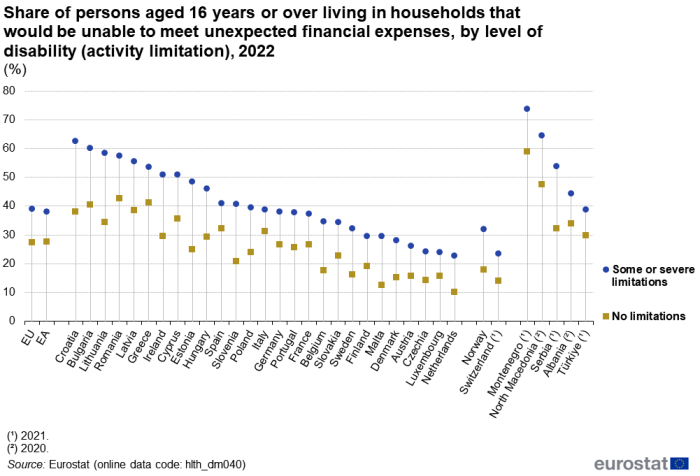
(%)
Source: Eurostat (hlth_dm040)
In 2022 in all EU Member States, people with a disability were more likely to be unable to meet an unexpected financial expense than people without a disability. There was substantial variation between Member States in the proportion of people with a disability living in households that would be unable to meet an unexpected financial expense. The highest shares were 62.5 % in Croatia and 60.1 % in Bulgaria, while shares were below one quarter in Czechia (24.2 %), Luxembourg (24.0 %) and the Netherlands (22.8 %) – see Figure 4.
Falling behind with payments
Financial difficulties may leave households unable to service their debts or to pay their usual expenses such as utility bills
In 2022, people with a disability in the EU were slightly more likely to live in a household that had been behind with payments (for a mortgage or rent, utility bills or hire purchases) during the previous 12 months than people without a disability: this share was 10.6 % for people with a disability compared with 8.2 % of the population without a disability.
In all EU Member States except for Greece, people with a disability were more likely to live in a household that had been behind with payments during the previous 12 months than people without a disability. In 2022, the percentage of people with a disability in such households was highest in Greece (40.3 %), Bulgaria (25.8 %) and Romania (22.3 %) – the only Member States with shares above 20.0 %. By contrast, the lowest shares were recorded in the Netherlands (3.5 %) and Czechia (3.0 %) – the only Member States with shares that were less than 5.0 %.
Focusing on older people in the EU, specifically those aged 65 years and over, in 2022 some 6.4 % of those with a disability lived in a household that had been behind with payments during the previous 12 months, compared with 3.8 % of the population without a disability.
In all EU Member States except for Estonia, older people with a disability were more likely to live in a household that had been behind with payments during the previous 12 months than older people without a disability. In 2022, the percentage of older people with a disability in such households was highest in Greece (33.0 %), Bulgaria (23.5 %) and Romania (20.3 %). The lowest shares were recorded in Austria (1.5 %), Czechia (1.3 %) and the Netherlands (0.6 %).
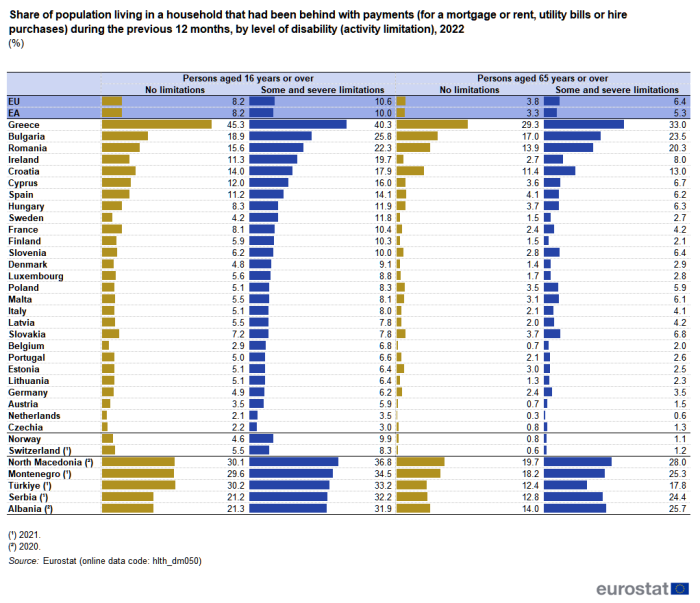
(%)
Source: Eurostat (hlth_dm050)
Source data for tables and graphs
![]() Disability statistics – financial situation: tables and figures
Disability statistics – financial situation: tables and figures
Data sources
EU-SILC is the source of comparative statistics on income distribution and social inclusion in the EU. It provides annual data for the EU Member States as well as most EFTA and enlargement countries on income, poverty, social exclusion and other aspects of living conditions.
The reference population for EU-SILC is limited to private households and their current members residing in the territory of the surveying country at the time of data collection. People living in collective households and institutions are generally excluded from the reference population; this constitutes a limitation for disability statistics. All household members are surveyed, but only those aged 16 years and over are interviewed.
The source is documented in more detail in this background article which provides information on the scope of the data, its legal basis, the methodology employed, as well as related concepts and definitions.
Context
Disability statistics are used in measuring the impact and effectiveness of the EU policy aimed at ensuring equal rights for persons with disabilities. Up to now, the EU has adopted several strategies aimed at improving the lives of persons with disabilities by reducing discrimination, inequalities and supporting persons with disabilities to fully enjoy their human rights, fundamental freedoms and EU rights on an equal basis with others. In light of this, the 2021-2030 EU Strategy for the rights of persons with disabilities sets the EU objectives and action priorities in several areas, such as accessibility, citizens' rights, quality of life, equal access and non-discrimination and the promotion of the rights of persons with disabilities. To find out more, please visit the webpage on the monitoring framework for the objectives and actions of this strategy.
To ensure sound monitoring and reporting of this topic, the European Commission is reinforcing the collection of data on the situation of persons with disabilities in areas where knowledge gaps have been identified, for example in relation to the labour market access.
The EU is also a signatory of the United Nations Convention on the Rights of Persons with Disabilities (CRPD).
Direct access to
Online publications
Related articles
- Health (hlth), see:
- Disability (hlth_dsb)
- Income distribution and poverty among disabled people - EU-SILC survey (hlth_dsb_pe)
- Material deprivation among disabled people - EU-SILC survey (hlth_dsb_md)